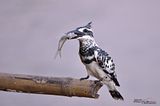Well, it was back in February 9th, only 2 days after my arrival back at home in Thailand. I headed right to Nam Kham Nature Reserve in Chiang Rai Province with Nuk, one of my birding colleagues, in search of the 2 rarities which appeared to be regular visitors to a waterhole inside the nature reserve area. These 2 rarities are White-tailed Rubythroat (Luscinia pectoralis tschebaiewi) the mascot of the nature reserve, and the Chestnut-crowned Bush Warbler (Cettia major). However, we've also been informed that the former has been absent from the waterhole for quite a while, as there was one bird photographer who put out worms in hope of attracting the bird, the worms instead brought out 2 aggressive male Siberian Rubythroats (Luscinia calliope) which finally made the shyer White-tailed Rubythroat disappeared. Mealworms are prohibited within the reserve area since then.




Baikal Bush Warbler (Bradypterus davidi); female/non-breeding?
 Common Sun Skink (Eutropis multifasciata)
Common Sun Skink (Eutropis multifasciata)We arrived at Nam Kham around 8 o'clock and went straight into the Cettia Hide, where both of the rarities were found. We were welcomed by the common stuff like Baikal Bush Warblers, Dusky Warblers and of course, Siberian Rubythroats. I didn't try the Rubythroat Hide, which is further in the reeds, since I didn't know that another rarity, the Chinese Bush Warbler (Bradypterus tacsanowskius) has just been found a few days earlier at that hide. We waited in the Cettia Hide until around 3:30pm, when the Chestnut-crowned Bush Warbler made its first appearance at the waterhole. It was already dark at that time, since the waterhole is located deep in the middle of reeds. The bird was very skittish at first and didn't come down to the waterhole. It later disappeared and showed up again at 4:00. This time it came down to the waterhole, but was chased off shortly after taking bath by the male Siberian Rubythroat. It appeared again at 4:30 and this time it took a really long bath before flying back into the reeds by itself.







Chestnut-crowned Bush Warbler (Cettia major)





Baikal Bush Warbler (Bradypterus davidi); heavily spotted breast (male?)
So we failed to see the male White-tailed Rubythroat, but at least we've got to see the great Chestnut-crowned Bush Warbler. These two birds were extremely rare before Nam Kham Nature Reserve was established. With extensive research and well protection, a great number of rare species is constantly reported from the area. The nature reserve is now a private area owned by Dr. Rungsrit Kanjanavanit, the chairman of my local bird club, Lanna Bird and Nature Conservation Club (LBNC), but is normally open for birders and researchers.
All videos captured by Nuk; apologies for my noisy shutter sound













































































.jpg)
